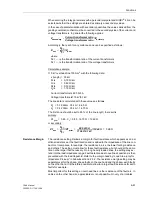
Functions
6-62
7SA6 Manual
C53000-G1176-C156-2
care should however be taken that an arc fault on the local cable termination is inside
the set resistance of the first zone.
The resistance of the line need not be taken into consideration since it was considered
through the shape of the polygon, provided the line angle in address
1105
Line An-
gle
(see Subsection 6.1.3, margin heading „General Line Data“) had been set cor-
rectly.
Example:
In the following example a maximum arc voltage of 8 kV is assumed for phase–phase
faults (line data as above). If the minimum primary fault current is assumed to be
1000 A this corresponds to 8
Ω
primary. This results in the following setting for the re-
sistance reach of the first zone:
primary:
or secondary:
Only half the arc resistance was applied in the equation, as it is added to the loop im-
pedance and therefore only half the arc resistance appears in the per phase imped-
ance.
A separate resistance margin can be set for earth faults. An arc resistance of 6
Ω
and
a tower footing resistance of 12
Ω
is assumed. This results in the following
primary:
or secondary:
In this case the least favourable condition was assumed, whereby the earth current
does not return via the measuring point. If all the earth current, or a portion of the earth
current flows via the measuring point, the measured resistance decreases. If the in-
feed comes from the remote end, the measured resistance may be increased.
Independent Zones
Z1 up to Z5
By means of the setting parameter
MODE
each zone can be set
Forward
or
Reverse
or
Non-Directional
(Address
1301
Op. mode Z1
,
1311
Op. mode Z2
,
1321
Op. mode Z3
,
1331
Op. mode Z4
and
1341
Op. mode Z5
). This allows any com-
bination of forward, reverse or non-directional graded zones, for example on trans-
formers, generators or bus couplers. In the fifth zone different reach in the X direction
can be set for forward or reverse. Zones that are not required, are set
Inactive
.
The values derived from the grading coordination chart are set for each of the required
zones. The setting parameters are grouped for each zone. For the first zone, Z1, these
are the parameters
R(Z1)
(address
1302
) for the R intersection of the polygon appli-
cable to phase-phase faults,
X(Z1)
(address
1303
) for the X intersection of the poly-
gon (reach),
RE(Z1)
(address
1304
) for the R intersection of the polygon applicable
to phase-earth faults as well as the relevant delay time settings.
R1
prim
1
2
---
R
arc
⋅
1
2
---
8
Ω
⋅
4
Ω
=
=
=
R1
sec
N
CT
N
VT
----------
R1
prim
⋅
600 A/5 A
110 kV/0.1 kV
--------------------------------------
4
Ω
⋅
0.44
Ω
=
=
=
R1E
prim
R
arc
R
tower
+
6
Ω
12
Ω
+
18
Ω
=
=
=
R1E
sec
N
CT
N
VT
----------
R1
prim
⋅
600 A/5 A
110 kV/0.1 kV
--------------------------------------
18
Ω
⋅
1.96
Ω
=
=
=
Summary of Contents for siprotec 7SA6
Page 2: ...Siemens Aktiengesellschaft Book No C53000 G1176 C156 2 ...
Page 18: ...xviii 7SA6 Manual C53000 G1176 C156 2 ...
Page 32: ...Introduction 1 14 7SA6 Manual C53000 G1176 C156 2 ...
Page 82: ...Hardware and Connections 2 50 7SA6 Manual C53000 G1176 C156 2 ...
Page 119: ...SIPROTEC 4 Devices 4 25 7SA6 Manual C53000 G1176 C156 2 Figure 4 20 CFC Logic example ...
Page 190: ...Configuration 5 62 7SA6 Manual C53000 G1176 C156 2 ...
Page 652: ...Installation and Commissioning 8 78 7SA6 Manual C53000 G1176 C156 2 ...
Page 724: ...Technical Data 10 56 7SA6 Manual C53000 G1176 C156 ...
Page 800: ...Appendix A 76 7SA6 Manual C53000 G1176 C156 2 ...
Page 866: ...Appendix B 66 7SA6 Manual C53000 G1176 C156 2 ...
















































